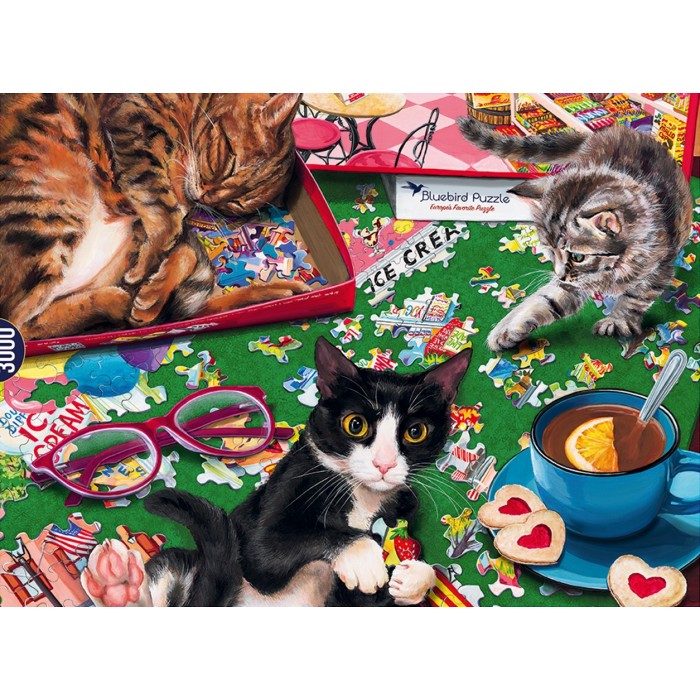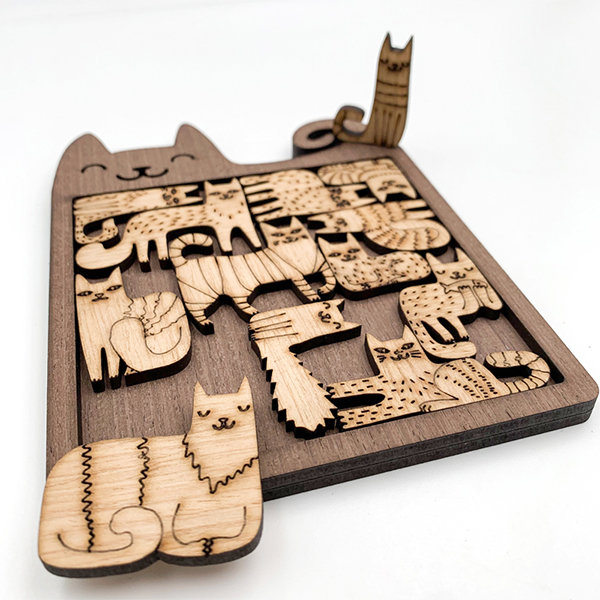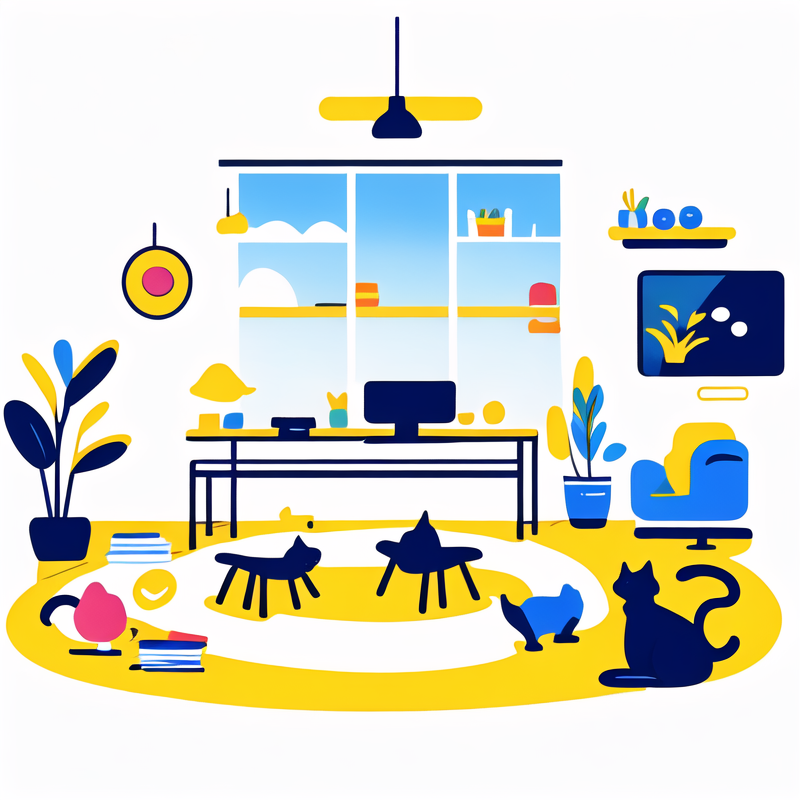The Importance of Mental Stimulation for Cats
Cat puzzles! Mental stimulation is crucial for your feline friend’s health and happiness. Like humans, cats need challenges that engage their minds and prevent boredom. Without enough stimulation, cats may develop unwanted behaviors. These can include aggression, over-grooming, or lethargy.

Cat puzzles offer an excellent way to keep your pet’s mind sharp. They stimulate natural hunting instincts. Puzzles also provide a form of entertainment that’s not only fun but beneficial. Regular mental exercise can improve your cat’s problem-solving abilities. It may even enhance their overall well-being.
When cats engage with puzzles, they use their senses to explore and understand. This includes sight, smell, and touch. It’s through this exploration that they experience a sense of accomplishment. Completing a puzzle can lead to a tasty treat or a favorite toy. Such rewards reinforce positive behavior, encouraging your cat to play more.
In addition to preventing boredom, mental stimulation through cat puzzles can decrease stress. A stressed cat might hide, refuse to eat, or even become destructive. Puzzles can provide the necessary focus to alleviate such stress. They redirect their energy into a positive activity.
Every cat deserves to enjoy an enriching environment. Cat puzzles are a simple and effective way to achieve this. They fit into any home and appeal to cats of all ages and sizes. By incorporating puzzles into your cat’s routine, you’re investing in their mental health. This can lead to a happier and more harmonious coexistence with your furry friend.
Types of Cat Puzzles Available
There are various cat puzzles on the market to suit all feline personalities and abilities. These puzzles often challenge cats to reach treats or toys by solving a problem or completing a task.
- Treat-Dispensing Puzzles: These require your cat to manipulate the puzzle to release a treat. They’re excellent for food-motivated cats.
- Slider Puzzles: Cats must use their paws to slide compartments open. Inside, they find their reward.
- Interactive Toys: Some puzzles have moving parts. Cats bat at them to spin or roll, often releasing treats.
- Feeder Balls: A ball that dispenses food as your cat plays with it, encouraging natural hunting behaviors.
- Puzzle Mats: Soft fabrics with hidden pockets for treats or kibble offer less structured playtime.
- Electric Puzzles: These are battery-operated toys that stimulate your cat’s hunting instinct with unpredictable movements.
When picking out a puzzle, consider your cat’s experience with play and their physical capabilities. Start with simpler designs if your cat is new to puzzles. You can introduce more complex ones as they get better. Remember, the aim is to challenge them but also for them to enjoy the playtime.

How to Choose the Right Puzzle for Your Cat
Choosing the right cat puzzle can feel overwhelming. Consider your cat’s age, interest level, and physical abilities. Younger cats may need more stimulating puzzles. These can keep up with their energy levels. Older cats might prefer slower, easier challenges. Observe how your cat plays. Does your cat paw at objects? Try slider puzzles. If your cat enjoys batting things, interactive toys could be ideal.
Look for durable toys. These will withstand sharp claws and teeth. Quality matters. A good puzzle endures through many play sessions. Adjust the difficulty level as needed. Start with easier puzzles for beginners. As your cat learns, introduce more complex puzzles to keep them engaged.
Consider safety always. Puzzles should be made of non-toxic materials. They should not have small parts that could be swallowed. Go for puzzles that suit your cat’s size. This prevents them getting their head or paws stuck.
Lastly, think about cleanup. You’ll need to clean and maintain the puzzle. Some puzzles are dishwasher-safe. Others need wiping with a cloth. Choose one that fits your cleaning routine.
By considering these factors, you can select a puzzle that offers great mental stimulation. It should also provide endless fun for your feline friend. With the right puzzle, watch your cat enjoy hours of interactive play while staying engaged and healthy.
DIY Cat Puzzle Ideas
Creating homemade cat puzzles is an easy and cost-effective way to enrich your cat’s environment. DIY puzzles can range from simple to complex, depending on your cat’s abilities and your creativity. Here are some ideas to get started:
- Box Maze: Use cardboard boxes to craft a maze. Cut holes in the sides for your cat to navigate through.
- Toilet Paper Roll Puzzle: Hide treats inside a toilet paper roll and fold the ends. Watch your cat figure out how to retrieve the snack.
- Egg Carton Treats: Place treats in an empty egg carton and close it. Cats can open compartments with their paws to find their reward.
- Sock Balls: Stuff a sock with crumpled paper and tie it to create a ball. Hide treats inside for your cat to discover.
- Bottle Spinner: Secure a plastic bottle horizontally on a base. Cut small holes in the bottle, put treats inside, and let your cat spin it to release them.
When crafting DIY puzzles, use safe materials with no sharp edges. Always supervise initial play to ensure safety. These puzzles stimulate your cat’s mind while adding variety to their daily activities. They also let you recycle materials, making them eco-friendly. Incorporating these homemade options can keep your cat’s interest peaked and provide a personal touch to their playtime.
Benefits of Cat Puzzles for Different Age Groups
Cat puzzles offer benefits for felines of all ages. They cater to each life stage’s specific needs, from spry kittens to serene seniors.
For Kittens
Kittens are balls of energy, always eager to explore and learn. Cat puzzles tailored for kittens focus on:
- Developing coordination and fine motor skills.
- Satisfying their high curiosity levels.
- Providing an outlet for boundless energy.
Engaging kittens with simpler puzzles helps shape their learning. This encourages positive play habits early on.
For Adult Cats
Adult cats benefit from puzzles that:
- Challenge their intellect and problem-solving skills.
- Keep their hunting instincts sharp.
These puzzles can prevent boredom and maintain their mental health as they mature.
For Senior Cats
With age, cats become less active but still need engagement. Puzzles for older cats should:
- Be easy on the joints.
- Stimulate the mind without excessive physical demand.
These puzzles can help senior cats stay sharp and prevent cognitive decline.
By choosing cat puzzles fit for their age group, you nurture your cat’s mental and physical health. This can lead to a more content and well-adjusted pet at every stage of their life.

Introducing Your Cat to Puzzles
Introducing your cat to puzzles can be a rewarding experience, but it’s important to do it right to ensure they enjoy it and remain interested. Begin with the following steps to ease your cat into the world of puzzles and mental stimulation:
- Start Simple: Choose puzzles with clear, achievable goals. This avoids frustration and keeps your cat eager for more.
- Use Enticing Rewards: Fill puzzles with your cat’s favorite treats. The scent will draw them in and motivate their play.
- Play Along: Initially, guide your cat through the puzzle. Show them how it works and praise their efforts.
- Keep Sessions Short: Short, positive sessions maintain interest. It prevents them from getting discouraged.
- Be Patient: Every cat learns at their own pace. Give yours time to get familiar with the new activity.
- Increase Complexity Gradually: Once your cat masters a puzzle, introduce a slightly harder one. Keep them challenged but not overwhelmed.
Remember, the goal is to make puzzles a fun and enriching part of your cat’s life. Your encouragement and a gentle approach can make all the difference. With time, your cat could be eagerly anticipating puzzle time as much as you do!
Advanced Puzzles for Smart Felines
When you have an intelligent and energetic cat, simple puzzles may no longer be enough. Cats that solve basic puzzles quickly can benefit from advanced cat puzzles. These puzzles challenge your pet to think harder and keep them engaged for longer. Here are some complex puzzles to consider for your clever kitty:
- Multi-Level Puzzles: These have multiple steps that cats must solve in sequence. They might need to move several pieces to reach a treat.
- Puzzle Wheels: Cats spin wheels with their paws to align holes and access hidden treats. It requires precision and patience.
- Lock Boxes: Treats are kept inside boxes that cats have to unlock. This might involve sliding bolts or lifting latches.
- Digital Puzzles: Interactive apps create virtual challenges for cats, often on a tablet or phone screen.
- Track Puzzles: Grooves and tracks hide balls or treats. Cats must navigate the paths to release them.
- Advanced Feeder Toys: These might combine various movements like rolling and spinning, requiring skill to release food.
Advanced puzzles offer stimulation that matches your cat’s abilities. Look for puzzles that make your cat use different senses and skills. Always introduce new puzzles gradually. Watch how your cat interacts. Some may prefer certain types of challenges over others. Adjusting to their preferences can help maximize the fun and the mental benefits they gain from these activities.
Maintaining Interest: Rotating and Updating Puzzles
Keeping your cat interested in puzzles is key to continued mental stimulation. Here’s how to keep them engaged:
- Rotate Puzzles: Don’t let puzzles become stale. Swap them out regularly. Your cat will enjoy the novelty.
- Increase Difficulty: As your cat gets better, make puzzles tougher. This keeps them challenged.
- Introduce Variety: Use different puzzle types. It’s stimulating and fun for your cat.
- Renew Old Puzzles: Sometimes, just hiding a puzzle for a while makes it exciting again.
- DIY Updates: Add new obstacles to homemade puzzles. It sparks curiosity and extends their life.
- Reward Wins: Positive reinforcement works. Praise your cat and offer treats for solving puzzles.
- Observe and Adjust: Watch how your cat interacts with puzzles. Change things up if needed.
- Social Play: Occasionally, join your cat in play. It builds bonds and keeps them keen.
Remember, the goal is to keep your cat’s mind active. Staying engaged with puzzles benefits their overall health. By using these strategies, you help maintain your cat’s interest in this essential activity.
